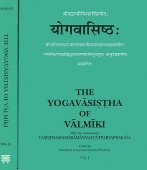Rajatarangini, Rājataraṅgiṇī, Rajan-tarangini: 3 definitions
Introduction:
Rajatarangini means something in Hinduism, Sanskrit. If you want to know the exact meaning, history, etymology or English translation of this term then check out the descriptions on this page. Add your comment or reference to a book if you want to contribute to this summary article.
In Hinduism
Purana and Itihasa (epic history)
Source: archive.org: Rajatarangini (Ranjit Sitaram Pandit)Rājataraṅgiṇī (राजतरङ्गिणी) or “river of kings” is a poem in Saṃskṛta (Sanskrit) in eight cantos. Each canto is called Taraṅga or Wave. The author of this saga of Kasmir is the poet Kalhaṇa who commenced his composition in the year 1148 A.C. (Śaka year 1070) and concluded it in 1150 A.C.

The Purana (पुराण, purāṇas) refers to Sanskrit literature preserving ancient India’s vast cultural history, including historical legends, religious ceremonies, various arts and sciences. The eighteen mahapuranas total over 400,000 shlokas (metrical couplets) and date to at least several centuries BCE.
Languages of India and abroad
Sanskrit dictionary
Source: DDSA: The practical Sanskrit-English dictionaryRājataraṅgiṇī (राजतरङ्गिणी).—Name of a celebrated historical poem treating of the kings of Kāśmīra by Kalhaṇa.
Rājataraṅgiṇī is a Sanskrit compound consisting of the terms rājan and taraṅgiṇī (तरङ्गिणी).
Source: Cologne Digital Sanskrit Dictionaries: Aufrecht Catalogus Catalogorum1) Rājataraṅgiṇī (राजतरङ्गिणी) as mentioned in Aufrecht’s Catalogus Catalogorum:—history of Kāśmīr, by Kalhaṇa. Io. 2769. Oxf. 147. K. 28. Report. Xi. Ben. 63. H. 119. 120. Oppert. 7380. Continuation by Jonarāja. Oxf. 147^b. Report. Xi. Xii. Continuation by Śrīvara, called Jainataraṅgiṇī. W. p. 165. Oxf. 147^a. Report. Xii. Continuation by Prājyabhaṭṭa, called Rājāvalipatākā. Oxf. 147^a. Report. Xii.
2) Rājataraṅgiṇī (राजतरङ्गिणी):—by Kalhaṇa. Stein 72. 73. Continuation by Śrīvara, called Jainataraṅgiṇī. Stein 73. Continuation by Prājyabhaṭṭa, called Rājāvalipatākā. Stein 73 (inc.).
3) Rājataraṅgiṇī (राजतरङ्गिणी):—by Kalhaṇa. Contionuation by Jonarāja and Śrīvara. Ulwar 958.
4) Rājataraṅgiṇī (राजतरङ्गिणी):—by Kalhaṇa. As p. 161. Io. 664 (1-6). 1146 (1-7 and 4). 2769 (1. 2. 4-8). 2848 (1-6). 3017 (1-8). Peters. 5, 377. Jonarāja’s Taraṅgiṇī Io. 837. No. 3979. Jainarājataraṅgiṇī by Śrīvara. Io. 1146. 2414. 2769. 2848. 2901.
Sanskrit, also spelled संस्कृतम् (saṃskṛtam), is an ancient language of India commonly seen as the grandmother of the Indo-European language family (even English!). Closely allied with Prakrit and Pali, Sanskrit is more exhaustive in both grammar and terms and has the most extensive collection of literature in the world, greatly surpassing its sister-languages Greek and Latin.
See also (Relevant definitions)
Partial matches: Tarangini, Rajan, Raja.
Starts with: Rajataranginisamgraha.
Full-text (+5488): Vollasaka, Kalhana, Durnripa, Hushkapura, Pratikara, Mulasrotas, Kshmavrisha, Sukharaja, Dhunana, Nihsamcara, Gananapati, Vaimatya, Cintana, Dranga, Rakka, Tipya, Alakhana, Yittha, Saritaka, Lolora.
Relevant text
Search found 25 books and stories containing Rajatarangini, Rājataraṅgiṇī, Rajan-tarangini, Rājan-taraṅgiṇī, Raja-tarangini, Rāja-taraṅgiṇī; (plurals include: Rajataranginis, Rājataraṅgiṇīs, taranginis, taraṅgiṇīs). You can also click to the full overview containing English textual excerpts. Below are direct links for the most relevant articles:
Rasa Jala Nidhi, vol 5: Treatment of various afflictions (by Bhudeb Mookerjee)
Part 17 - Chemists of the Metallic School: Nagarjuna < [A Brief History of Indian Chemistry and Medicine]
Part 22 - Chemists of the Metallic School: Vagbhata, the junior < [A Brief History of Indian Chemistry and Medicine]
Part 14 - Chemists of the Metallic School: Shambhu < [A Brief History of Indian Chemistry and Medicine]
The backdrop of the Srikanthacarita and the Mankhakosa (by Dhrubajit Sarma)
Appendix: 12th century Kashmir (extracted from Rajatarangini introduction)
Part 6 - Maṅkhaka: his genealogy and date < [Chapter I - Introduction]
Part 8d - Sites of pilgrimage (found in the Śrīkaṇṭhacarita) < [Chapter IV - Socio-cultural study of the Śrīkaṇṭhacarita]
Satirical works of Kshemendra (study) (by Arpana Devi)
3. Kṣemendra’s Birth Place < [Chapter 2 - Kṣemendra: His Life and Works]
1. Date and Literary Career of Kṣemendra < [Chapter 2 - Kṣemendra: His Life and Works]
7.11. Summary of the Bhallaṭaśataka < [Chapter 1 - Introduction]
Amarakoshodghatana of Kshirasvamin (study) (by A. Yamuna Devi)
Politics and Administration (7): Women rulers < [Chapter 3 - Social Aspects]
Date of Kṣīrasvāmin < [Chapter 2 - Kṣīrasvāmin: Life and Works]
Lakulisha-Pashupata (Philosophy and Practice) (by Geetika Kaw Kher)
Traces of Lakulisa-Pasupata order in North India < [Chapter 2 - Spread and Transition]
Samkaracarya and Kapalikas < [Chapter 2 - Spread and Transition]
Evidence of Ajivika cult in Kashmir < [Chapter 2 - Spread and Transition]
Alamkaras mentioned by Vamana (by Pratim Bhattacharya)
2: Date and Authorship < [Chapter 1 - Introduction]
Related products
